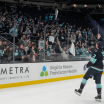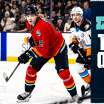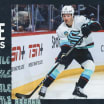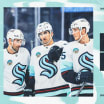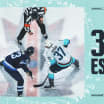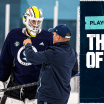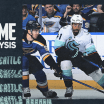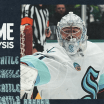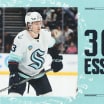When fans consider hockey analytics, they no doubt think statistics, numbers, data, all things math and science. This past Saturday's 2022 SEAHAC analytics conference highlighted the vital human element of digging deeper into hockey performance. More than three dozen presenters spoke to 250 attendees about the latest research, on-ice theorems and, most strikingly, their careers and lives in hockey.
"I've always been a hockey fan," said Campbell Weaver during a mid-day "Technology in a Hockey Organization" panel. "It wasn't until I was in grad school [getting a master's degree in machine learning and computer vision] that I got into hockey analytics."
2022 SEAHAC: Can You Dig It?
All-day hockey analytics conference deeply informs sold-out crowd with impressive input from Kraken hockey operations, nine other NHL teams. It's available to watch online
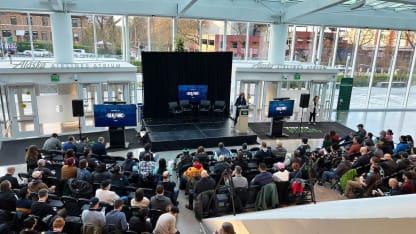
Weaver discovered he could combine his love of the sport with his field of studies. He even devised and executed a research study about how to use artificial intelligence technology to map player movements on the ice. He presented at an Ottawa, ON, analytics conference in 2018. The Boston Bruins took notice and that scientific paper turned into a job offer to join Boston as a data engineer.
His advice to aspiring data engineers in the audience: Do your own research work, pick a topic or area about which you can get passionate and pursue it in-depth to show how you analyze a specific aspect of how hockey players and teams can get better.
There were plenty of other presenters who personify blending love of hockey and love of data. Corey Sznajder, who has tracked more than 3,000 NHL games since 2016, started his "
All Three Zones
" project as a hobby and has since gained enough subscribers or patrons to make it a full-time job providing "micro stats" that include zone entries, zone exits and transition data on how teams go from offense to defense and vice versa.
Other data scientists use Sznajder's publicly available data to write their own studies while the "All Three Zones" creator says the data project has greatly enhanced his understanding of the sport. His talk Saturday examined from which zones and how the NHL's most successful teams create offensive rush goals, using data points about counterattacks, controlled plays and neutral zone regroups.
Sznajder was followed by Micah Blake McCurdy during a powerhouse afternoon hour (Kraken colleague and ROOT SPORTS analyst Alison Lukan was right when she told attendees "you won't want to miss these next two presentations!"). McCurdy is part-time math professor in Nova Scotia who started the website
Hockeyviz.com
. His sweet spot is data visualization, helping every level of hockey fans appreciate NHL trends and underlying numbers in a glance.
"I intend to make all of my research available to the public, for free," writes McCurdy on his website. "I find working in this way to be immensely satisfying. I do not aspire to a team position, especially not if it requires removing my public work from the internet, as we have seen in a number of prominent cases."
Interested fans can become HockeyViz members or subscribers who get access to his latest visualizations (a personal favorite are his heat maps to indicate where goals are scored and by which type of shots, but there is so much in his graphic repertoire). In a stroke of genius by Lukan and the Kraken's digital manager, Marissa Simmons, the SEAHAC co-leaders scheduled McCurdy during a post-lunch time slot that sometimes gets minds wandering and/or eyes on phone screens. No chance with McCurdy bringing an informative point-of-view and a sense of humor as accessible as his public data sets.
A few words about Simmons and Lukan, who nailed every detail of the event. While juggling their in-season heavy workload, they organized a lively, sold-out conference that included representatives from 10 NHL teams and more than 100 data scientists and software developers who work with data in their professional lives. About 70 percent of attendees converged inside the Alaska Airlines Atrium at Climate Pledge Arena on a game day came from the greater Seattle area, while the other 30 percent traveled into Seattle from across the U.S. and Canada. Presenters and attendees alike raved about the info-packed, thought-provoking day on stage, enjoyed a bountiful pizza and salad lunch sponsored by the hockey data company SportLogiq, and engaged in hundreds of impromptu conversations with no shortage of coffee (with team partner Starbucks also supplying reusable to-go cups to keep with the sustainability of the Kraken's home arena).
Speaking of Kraken colleagues, there was impressive SEAHAC representation from the hockey operations group, including GM Ron Francis, assistant general manager Alexandra Mandrycky, senior quantitative analyst Namita Nandakumar, quantitative analyst Dani Chu, hockey operations developer Eric Mathiasen, amateur scout Chris MacDonald, head strength and conditioning coach Nate Brookreson, head video analyst Tim Ohashi on Dave Hakstol's coaching staff and ROOT SPORTS analyst JT Brown.
Nandakumar was a star moderator on the opening panel with Chu and fellow quantitative analysts Aiden Fox of the Vancouver Canucks and Arik Parnass of the 2021 Stanley Cup champion Colorado. In fact, Nandakumar's questions generated such insightful replies that both Mandrycky and Lukan, moderators of other Saturday panels, openly "stole" some questions to use in their presentations.
Chu provided a glimpse into how the Kraken consider both the analytics and scouting points of view when evaluating players and specifically credited Ohashi and assistant general manager Jason Botterill with challenging the analytics group to refine their work to better serve the team's needs in deciding on players to draft, sign as free agents or acquire in trades.
Brookreson's answers were sit-up-and-notice on how and why the Kraken strength and conditioning staff collect data on practices and workouts, but without overloading players in the process. It's clear Brookreson applies a scientific foundation to his work with the Kraken, which fits right in the SEAHAC theme and purpose. Brown and Lukan, who collaborate with each other to add substantial value to ROOT broadcasts and provide some fun debates for any of us fortunate enough to work alongside them, engaged in a front-facing talk about how they both view analytics, especially how Brown's experience as an NHL player now is balanced with his thriving work as an analyst informing fans.
There's so much more to report about the 2022 SEAHAC, including an analytics 101-type talk by Sound of Hockey founder John Barr, who staged the first SEAHAC in 2019 and devoted the last decade to being an influential voice for fans focused on getting an NHL franchise for Seattle. Lucky for all of us, fans can
the entire conference or preferred presentation. What's more, a devoted
landing page provides support materials
and a number of studies for fans who, stick tap to our "Analytics with Alison" columns," might be thinking "let's dig in."



